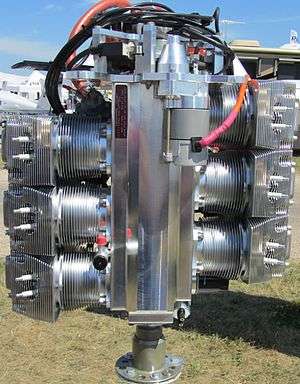Jabiru 3300
| Jabiru 3300 | |
|---|---|
 | |
| Type | Piston aero engine |
| National origin | Australia |
| Manufacturer | Jabiru Aircraft |
| Unit cost | US$18,500.00 (2010) |
| Developed into | Jabiru 5100 |
The Jabiru 3300 is a lightweight four-stroke, horizontally opposed "flat-six" air-cooled aircraft engine produced by Jabiru Aircraft. The engines are direct drive and fitted with alternators, silencers, vacuum pump drives and dual ignition systems as standard. The engine is used to power homebuilt and ultralight aircraft.

History
In November 2014 the Australian Civil Aviation Safety Authority proposed restricting all Jabiru-powered aircraft to day-visual flight rules only, without passengers or solo students and within gliding distance of a safe place to land due to the engine line's safety record. This was in response to 46 reports of engine failure in flight. In flight failure modes included, but were not limited to: fuel starvation; valve/port collapse & breakage of critical bolts.[1][2][3] Both the manufacturer and Recreational Aviation Australia opposed the restrictions as unnecessary and unwarranted.[4] The final rule adopted somewhat softened the restrictions, allowing the carriage of passengers and students, but requiring them to sign an acknowledgement of risk before flying and restricting equipped aircraft to day VFR flight and within gliding distance of a safe place to land.[5]
A subsequent tear-down of one engine by CASA resulted in recommendations in June 2016 for further easing of the restrictions.[6]
Applications
- Aerocomp VM-1 Esqual
- Albaviation D24 MagicOne
- Alpi Pioneer 300
- Arion Lightning
- Australian Lightwing SP-2000 Speed
- BRM Argos
- Bushcaddy R-120
- Creative Flight Aerocat
- CZAW Parrot
- Fisher Dakota Hawk
- Flaeming Air FA 04 Peregrine
- Ion Aircraft Ion
- Jabiru J230
- Jabiru J430
- Just Superstol
- MySky MS One
- Nexaer LS1
- Pulsar Aircraft Pulsar
- Rand Robinson KR-2S
- Sonex Aircraft Sonex
- Titan Tornado
- ULBI Wild Thing
Specifications
General characteristics
- Type: Flat-6
- Bore: 97.5 mm (3.84 in)
- Stroke: 74 mm (2.91 in)
- Displacement: 3,300 cm³ (201.4 in³)
- Length: 671 mm (26.42 in)
- Width: 582 mm (22.91 in)
- Height: 445 mm (17.54 in)
- Dry weight: 81 kg (178 lbs) with exhaust, carburetors, starter motor, alternator & ignition system
Components
- Fuel system: Mechanical fuel pump
- Fuel type: AVGAS 100/130 or Auto Gas 91 MON (97 RON) Minimum
- Oil system: Wet sump
- Cooling system: Air-cooled, oil cooling (optional, but usually necessary)
Performance
- Power output: 79.8 kW (107 hp) at 2,750 RPM (continuous); 89.5 kW (120 hp) at 3,300 RPM (intermittent)
- Compression ratio: 8:1
- Power-to-weight ratio: 1.10 kW/kg
See also
Comparable engines:
References
- ↑ RA-Aus Response, Sport Pilot Magazine (Australia), Feb 2015, page 27
- ↑ "Limitations on aircraft with Jabiru engines - Shine Lawyers". Shine Lawyers. Retrieved 29 May 2016.
- ↑ "CASA issues Jabiru Engine Update". australianflying.com.au. Retrieved 29 May 2016.
- ↑ Niles, Russ (15 November 2014). "Australia Eyes Jabiru Restrictions". AVweb. Retrieved 17 November 2014.
- ↑ Niles, Russ (21 December 2014). "CASA Issues Jabiru Final Rule". AVweb. Retrieved 22 December 2014.
- ↑ Civil Aviation Safety Authority (8 June 2016). "Jabiru Engine Reliability" (PDF). jabiruna.com. Retrieved 13 March 2017.